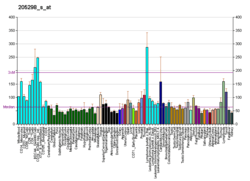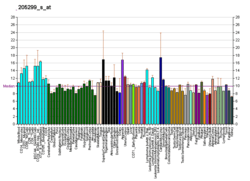Butyrophilin, subfamily 2, member A2
Butyrophilin subfamily 2 member A2 is a protein that in humans is encoded by the BTN2A2 gene.[5][6][7]
Function
Butyrophilin is the major protein associated with fat droplets in the milk. This gene is a member of the BTN2 subfamily of genes, which encode proteins belonging to the butyrophilin protein family. The gene is located in a cluster on chromosome 6, consisting of seven genes belonging to the expanding B7/butyrophilin-like group, a subset of the immunoglobulin gene superfamily. The encoded protein is a type 1 receptor glycoprotein involved in lipid, fatty-acid and sterol metabolism. Several alternatively spliced transcript variants of this gene have been described, but the full-length nature of some variants has not been determined.[7]
gollark: People were complaining about supply chain disruption and how clearly everywhere needs to be self-sufficient during the start of the whole people-noticing-COVID-19 thing, but it seems like, on the whole, there was mostly food and stuff around and it got resolved fairly fast.
gollark: Stuff does manage to mostly function, most of the time, somehow.
gollark: I kind of want to read Worm, or at least some of it, to actually understand what half of this is about.
gollark: In TCP, that is.
gollark: I'm interested in it, but it's several million words or something so I've been scared off reading it.
References
- GRCh38: Ensembl release 89: ENSG00000124508 - Ensembl, May 2017
- GRCm38: Ensembl release 89: ENSMUSG00000053216 - Ensembl, May 2017
- "Human PubMed Reference:". National Center for Biotechnology Information, U.S. National Library of Medicine.
- "Mouse PubMed Reference:". National Center for Biotechnology Information, U.S. National Library of Medicine.
- Henry J, Miller MM, Pontarotti P (June 1999). "Structure and evolution of the extended B7 family". Immunology Today. 20 (6): 285–8. doi:10.1016/S0167-5699(98)01418-2. PMID 10354554.
- Ruddy DA, Kronmal GS, Lee VK, Mintier GA, Quintana L, Domingo R, Meyer NC, Irrinki A, McClelland EE, Fullan A, Mapa FA, Moore T, Thomas W, Loeb DB, Harmon C, Tsuchihashi Z, Wolff RK, Schatzman RC, Feder JN (May 1997). "A 1.1-Mb transcript map of the hereditary hemochromatosis locus". Genome Research. 7 (5): 441–56. doi:10.1101/gr.7.5.441. PMID 9149941.
- "Entrez Gene: BTN2A2 butyrophilin, subfamily 2, member A2".
Further reading
- Cavaletto M, Giuffrida MG, Fortunato D, Gardano L, Dellavalle G, Napolitano L, Giunta C, Bertino E, Fabris C, Conti A (July 2002). "A proteomic approach to evaluate the butyrophilin gene family expression in human milk fat globule membrane". Proteomics. 2 (7): 850–6. doi:10.1002/1615-9861(200207)2:7<850::AID-PROT850>3.0.CO;2-C. PMID 12124930.
- Rhodes DA, Stammers M, Malcherek G, Beck S, Trowsdale J (February 2001). "The cluster of BTN genes in the extended major histocompatibility complex". Genomics. 71 (3): 351–62. doi:10.1006/geno.2000.6406. PMID 11170752.
External links
- BTN2A2 human gene location in the UCSC Genome Browser.
- BTN2A2 human gene details in the UCSC Genome Browser.
This article is issued from Wikipedia. The text is licensed under Creative Commons - Attribution - Sharealike. Additional terms may apply for the media files.





